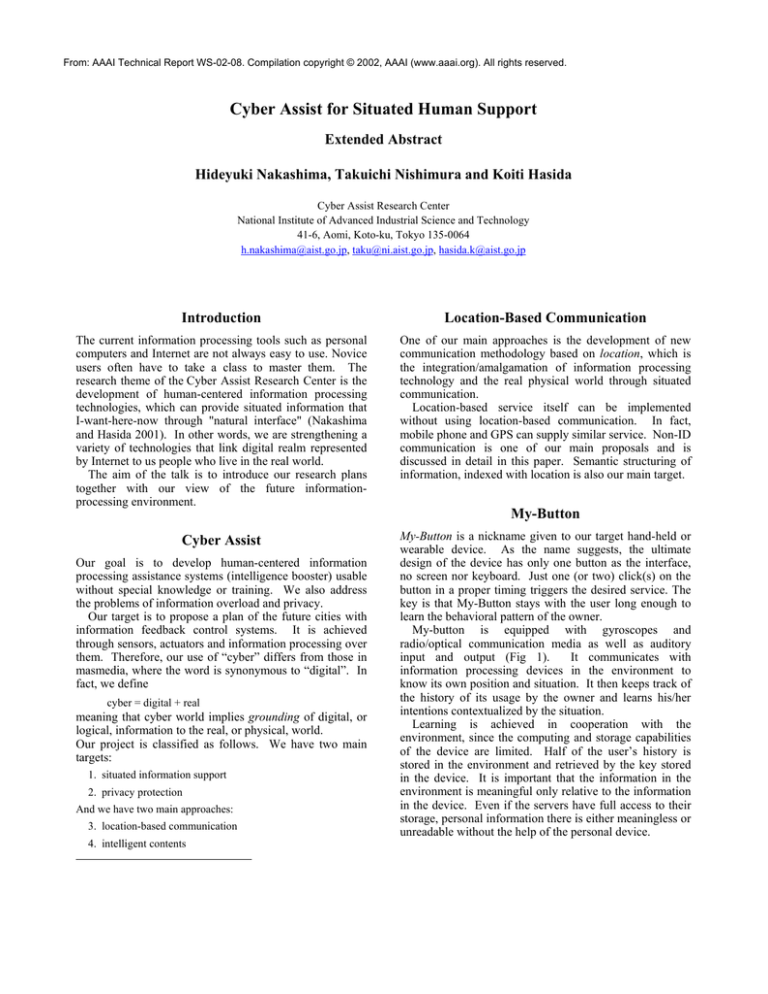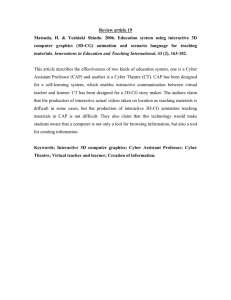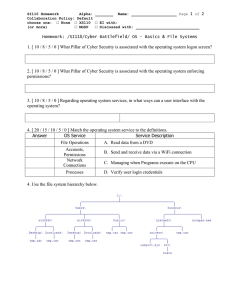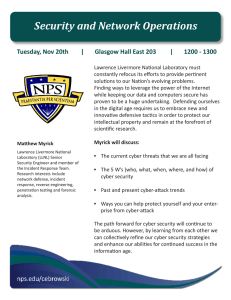
From: AAAI Technical Report WS-02-08. Compilation copyright © 2002, AAAI (www.aaai.org). All rights reserved.
Cyber Assist for Situated Human Support
Extended Abstract
Hideyuki Nakashima, Takuichi Nishimura and Koiti Hasida
Cyber Assist Research Center
National Institute of Advanced Industrial Science and Technology
41-6, Aomi, Koto-ku, Tokyo 135-0064
h.nakashima@aist.go.jp, taku@ni.aist.go.jp, hasida.k@aist.go.jp
Introduction
Location-Based Communication
The current information processing tools such as personal
computers and Internet are not always easy to use. Novice
users often have to take a class to master them. The
research theme of the Cyber Assist Research Center is the
development of human-centered information processing
technologies, which can provide situated information that
I-want-here-now through "natural interface" (Nakashima
and Hasida 2001). In other words, we are strengthening a
variety of technologies that link digital realm represented
by Internet to us people who live in the real world.
The aim of the talk is to introduce our research plans
together with our view of the future informationprocessing environment.
One of our main approaches is the development of new
communication methodology based on location, which is
the integration/amalgamation of information processing
technology and the real physical world through situated
communication.
Location-based service itself can be implemented
without using location-based communication. In fact,
mobile phone and GPS can supply similar service. Non-ID
communication is one of our main proposals and is
discussed in detail in this paper. Semantic structuring of
information, indexed with location is also our main target.
Cyber Assist
My-Button is a nickname given to our target hand-held or
wearable device. As the name suggests, the ultimate
design of the device has only one button as the interface,
no screen nor keyboard. Just one (or two) click(s) on the
button in a proper timing triggers the desired service. The
key is that My-Button stays with the user long enough to
learn the behavioral pattern of the owner.
My-button is equipped with gyroscopes and
radio/optical communication media as well as auditory
input and output (Fig 1).
It communicates with
information processing devices in the environment to
know its own position and situation. It then keeps track of
the history of its usage by the owner and learns his/her
intentions contextualized by the situation.
Learning is achieved in cooperation with the
environment, since the computing and storage capabilities
of the device are limited. Half of the user’s history is
stored in the environment and retrieved by the key stored
in the device. It is important that the information in the
environment is meaningful only relative to the information
in the device. Even if the servers have full access to their
storage, personal information there is either meaningless or
unreadable without the help of the personal device.
Our goal is to develop human-centered information
processing assistance systems (intelligence booster) usable
without special knowledge or training. We also address
the problems of information overload and privacy.
Our target is to propose a plan of the future cities with
information feedback control systems. It is achieved
through sensors, actuators and information processing over
them. Therefore, our use of “cyber” differs from those in
masmedia, where the word is synonymous to “digital”. In
fact, we define
cyber = digital + real
meaning that cyber world implies grounding of digital, or
logical, information to the real, or physical, world.
Our project is classified as follows. We have two main
targets:
1. situated information support
2. privacy protection
And we have two main approaches:
3. location-based communication
4. intelligent contents
My-Button
photo detector
reflectors
microphon
logical location. Your queries and private content may
contain a lot of deixes, and the spatiotemporal location
obtained through location-based communication provides
the anchor point in the real world that renders those deixes
meaningful.
Application Images
speaker
command button
fingerprint recognizer
Fig 1 A design of “My-Button”
Since we use location-based communication protocol,
the server has no clue to know the identity of the owner of
the device. This is the key point of our implementation.
Otherwise, our personal history will be open to the public
and may be abused.
We have implemented the first version of My-Button as
a very simple compact batteryless information terminal
(CoBIT) (Nishimura et al. 2002). CoBIT is equipped with
a reflective sheet, whose location can be easily identified
from cameras mounted in the environment. It can receive
infrared signal and replays it as auditory information. The
infrared beam itself is the power source of CoBIT, thus
there is no need to have any internal power supply.
Intelligent Contents
A major cause of information overload and digital divide is
the semantic gap between humans and computers; humans
are better at dealing with deep meaning and machines are
better at processing explicit syntax. The only feasible way
to systematically fill this gap at the state of the art for the
coming several decades or perhaps this century is to make
the semantic structure of information content explicit so
that machines can deal with them too.
Intelligent content (Hasida 2000) is information content
annotated in terms of explicit semantic structure, which is
typically predicate-argument structure or semantic network
addressing the propositional content
Under location-based communication, the location
contributes very much to plugging the private and the
public contents. Namely, your spatiotemporal location
allows you to use deixes: linguistic expressions, such as I,
you, here, there, now, a while ago, and so forth, which
make sense relative to the addressor’s spatiotemporal or
Exhibition Guide
The first version of My-Button, CoBIT, is ideal for lowcost guidance terminal for museum exhibitions. It can
provide location-dependent as well as personalized
information, possibly tuned to the knowledge level and/or
linguistic preference of the guest.
Information Infrastructure for Rescue
One of an important application of My-button is disaster
rescue. My-button’s become a secondary information
infrastructure, which can form an ad-hoc network using
their short-range communications. We are building a
realistic simulator to plan and test the best networking
strategies.
Cyber Mart
If a shopping cart and stock shelves can communicate each
other, there is a large room for supporting shoppers. One
of our targets is an automatic payment at the cash register,
or shopping without going through the checkout counter.
References
Hasida, K. 2000.
GDA: Annotated Document as
Intelligent Content'. Invited talk at COLING 2000
Workshop on Semantic Annotation and Intelligent Content,
Luxembourg.
Nakashima, H. and Hasida, K. 2001. Location-based
Communication Infrastructure for Situated Human Support.
In Proceedings of SCI 2001(World Multiconference on
Systemics, Cybernetics and Informatics), 2001. "LocationBased Wireless/Optical Communication for Situated
Human Support"-Invited Session.
Nishimura, T.; Itoh, H.; Yamamoto, Y. and Nakashima, H.
2002. A Compact Battery-less Information Terminal
(CoBIT) for Location-based Support Systems, In
Proceedings of International Symposium on Optical
Science and Technology (SPIE), 4863B-12.




